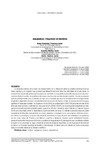Identificador persistente para citar o vincular este elemento:
https://accedacris.ulpgc.es/jspui/handle/10553/105976
| Campo DC | Valor | idioma |
|---|---|---|
| dc.contributor.author | Balea Fernandez, Francisco Javier | en_US |
| dc.contributor.author | González Medina, Sonia | en_US |
| dc.contributor.author | Alonso Ramírez, Javier | en_US |
| dc.date.accessioned | 2021-03-19T17:35:39Z | - |
| dc.date.available | 2021-03-19T17:35:39Z | - |
| dc.date.issued | 2020 | en_US |
| dc.identifier.issn | 0214-9877 | en_US |
| dc.identifier.uri | https://accedacris.ulpgc.es/handle/10553/105976 | - |
| dc.description.abstract | La verdadera esencia del proceso de envejecimiento es la interacción entre la subjetiva disminución en elplano cognitivo y no cognitivo que produce una alteración funcional sobre las actividades de la vida diaria. Laevolución de la pirámide poblacional ha puesto de manifiesto un importante incremento de proporción de ancia-nos/as en todo el mundo y sin establecer de manera clara los roles sociales de este colectivo. Uno de los mayoresfactores predisponentes para el maltrato al mayor es el concepto que tiene la sociedad sobre el envejecimiento(fragilidad y dependencia) unido a un debilitamiento de vínculos familiares y la falta de recursos económicos paragarantizar el adecuado cuidado. En España en el año 2018, se contabilizaron 2.037.700 personas de más de 65años que viven solos/as, a este dato se une que en el año 2019 el 29,93% de mayores padecía dependencia; datoque se incrementa exponencialmente cuando superan los 80 años. Se estima que el maltrato en mayores llega al52,6% en comunidad, siendo la dependencia el principal factor de riesgo. El maltrato a personas mayores puedepresentarse de diferentes maneras tanto por abuso, abandono o negligencia con unos signos y síntomas concre-tos; siendo la psicológica la manera más frecuente de maltrato al mayor. El perfil del maltratado/a se caracterizapor ser mujer; mayor de 75 años y con deterioro cognitivo o demencia; mientras que el maltratador/a familiar,carece de suficientes recursos económicos y cuidados de larga duración. El abordaje en caso de detectar maltratoal mayor en la comunidad se sigue a través de un plan de actuación respaldado por la Organización Mundial dela Salud y la Sociedad Española de Geriatría y Gerontología. El interés sobre el maltrato en los/as ancianos/astiene un creciente interés en la literatura científica. | en_US |
| dc.description.abstract | The true essence of the aging process is the interaction between the subjectivedecrease in the cognitive and non-cognitive plane that produces a functional alteration on the activities of dailylife. The evolution of the population pyramid has revealed a significant increase in the proportion of the elderlythroughout the world and without clearly establishing the social roles of this group. One of the biggest predispo-sing factors for elder abuse is the concept that society has about aging (fragility and dependency) together with aweakening of family ties and the lack of economic resources for adequate care. In Spain in 2018, 2,037,700 peo-ple over 65 who lived alone were counted, this data joins that in 2019 29.93% older suffered from dependency;data that increases exponentially when they exceed 80 years. It is estimated that elder abuse reaches 52.6% in thecommunity, with dependency being the main risk factor. Elder abuse can present different forms of abuse, neglector neglect with specific signs and symptoms; being the psychological the most frequent way of elder abuse. Theprofile of the abused is characterized by being a woman; 75-year-old mayor with cognitive disabilities or demen-tia; while the abuser /arelative, with limited financial resources and long-term care. The approach in case ofdetecting mistreatment of the mayor in the community, follows an action plan backed by the World HealthOrganization and the Spanish Society of Geriatrics and Gerontology. Interest in elder abuse has a growing interestin the scientific literature. | en_US |
| dc.language | spa | en_US |
| dc.relation.ispartof | INFAD | en_US |
| dc.source | Revista INFAD de Psicología. International Journal of Developmental and Educational Psychology [ISSN 0214-9877], v. 1, p. 235-245 | en_US |
| dc.subject | 32 Ciencias médicas | en_US |
| dc.subject | 61 Psicología | en_US |
| dc.subject.other | Maltrato | en_US |
| dc.subject.other | Negligencia | en_US |
| dc.subject.other | Anciano | en_US |
| dc.subject.other | Dependencia | en_US |
| dc.title | Negligencia y maltrato en mayores | en_US |
| dc.title.alternative | Elder abuse and neglect | en_US |
| dc.type | info:eu-repo/semantics/article | en_US |
| dc.identifier.doi | 10.17060/ijodaep.2020.n1.v1.1780 | en_US |
| dc.description.lastpage | 245 | en_US |
| dc.description.firstpage | 235 | en_US |
| dc.relation.volume | 1 | en_US |
| dc.investigacion | Ciencias de la Salud | en_US |
| dc.type2 | Artículo | en_US |
| dc.description.numberofpages | 11 | en_US |
| dc.utils.revision | Sí | en_US |
| dc.date.coverdate | Abril 2020 | en_US |
| dc.identifier.ulpgc | Sí | en_US |
| dc.contributor.buulpgc | BU-MED | en_US |
| dc.description.dialnetimpact | 0,0 | |
| dc.description.dialnetq | Q3 | |
| dc.description.dialnetd | D7 | |
| dc.description.erihplus | ERIH PLUS | |
| item.fulltext | Con texto completo | - |
| item.grantfulltext | open | - |
| crisitem.author.dept | GIR IUMA: Diseño de Sistemas Electrónicos Integrados para el procesamiento de datos | - |
| crisitem.author.dept | IU de Microelectrónica Aplicada | - |
| crisitem.author.dept | Departamento de Psicología, Sociología y Trabajo Social | - |
| crisitem.author.orcid | 0000-0003-2028-0858 | - |
| crisitem.author.parentorg | IU de Microelectrónica Aplicada | - |
| crisitem.author.fullName | Balea Fernandez, Francisco Javier | - |
| crisitem.author.fullName | Alonso Ramírez, Javier | - |
| Colección: | Artículos | |
Visitas
229
actualizado el 27-sep-2025
Descargas
212
actualizado el 27-sep-2025
Google ScholarTM
Verifica
Altmetric
Comparte
Exporta metadatos
Los elementos en ULPGC accedaCRIS están protegidos por derechos de autor con todos los derechos reservados, a menos que se indique lo contrario.
